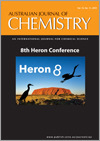
Australian Journal of Chemistry
Volume 72 Number 11 2019
RESEARCH FRONT: 8th Heron Conference
CHv72n11_FOHeron8 – The 8th Heron Conference on Reactive Intermediates and Unusual Molecules

This special issue of the Journal contains a collection of papers authored by participants at the 8th Heron Conference on Reactive Intermediates and Unusual Molecules, which was held at Ayers Rock Resort.
CH19206Isotope and Temperature Effects on the Electronic Spectra of Large Carbonaceous Molecular Ions of Interstellar Relevance
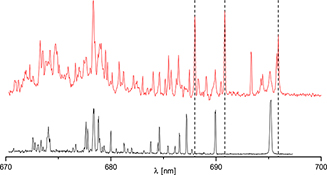
The electronic spectra of isotopologues of protonated coronene in the gas phase were measured below 10 K in a cryogenic trap. Wavelength shifts to the (1) 1A′ ← X 1A′ transition upon 13C substitution are observed and additional features appear in the spectrum of monodeuterated coronene. The implications for potential detection in interstellar clouds are considered.
CH19252A Scalable, Combined-Batch, and Continuous-Flow Synthesis of a Bio-Inspired UV-B Absorber
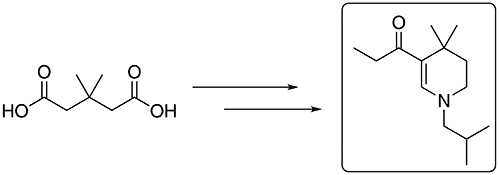
A new, chromatography-free synthesis for the preparation of an experimental UV-B absorber is reported. A key step of the process is a one-pot partial reduction of a symmetrical imide with a sequential dehydration step. The synthesis uses several continuous-flow steps to increase sample throughput and was used to prepare approximately 0.5 kg of the material over several batches in >99 % purity.
CH19338Crystal Structure of Burgess Inner Salts and their Hydrolyzed Ammonium Sulfaminates
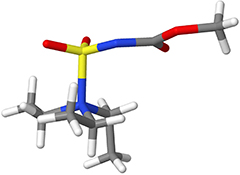
The Burgess reagent is reexamined to shed light on its structure and reactivity. Theoretical modelling of this useful reagent suggests certain parallels between N→B dative bonding in amine boranes and the dative N→S bond of the Burgess reagent. These bonding and reactivity features are evident in the solid state structure of the Burgess reagent.
CH19336Oil Spill Source Identification Using Colorimetric Detection
 and George Vamvounis
and George Vamvounis 

Colorimetric identification of oil spills is demonstrated by using an array of photochromic molecules.
CH19330Gold-Catalysed Oxidative Cycloisomerisation of 1,6-Diyne Acetates to 1-Naphthyl Ketones
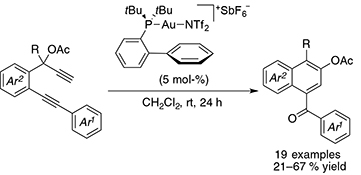
A synthetic method to prepare 1-naphthyl ketones from gold(i)-catalysed oxidative cycloisomerisation of 1,6-diyne acetates is described. The proposed mechanism involves cyclopropenation–cycloreversion of the 1,6-diyne motif initiated by a [2,3]-sigmatropic rearrangement. This is followed by nucleophilic attack of the ensuing gold carbenoid species by a molecule of water and autoxidation to give the aromatic product.
CH19379Generation and Rearrangement of (1-Hydroxycyclopropyl)- and (1-Hydroxycyclobutyl)carbene

Two cyclopropanated phenanthrene derivatives have been synthesized and photolyzed in solution to produce (1-hydroxycyclopropyl)- and (1-hydroxycyclobutyl)carbene. The carbenes rearrange by ring expansion.
CH19248Contemplating 1,2,4-Thiadiazole-Inspired Cyclic Peptide Mimics: A Computational Investigation

1,2,4-Thiadiazole-lissoclinamide 9, a next generation mimic design, was evaluated in silico for metal binding aptitude towards CuII ions. DFT calculations suggest that TDA-lissoclinamide may be capable of forming a complex with one CuII ion, [Cu(9-H)(H2O)]+. These results underpin future synthetic and experimental metal binding studies.
CH19323Carbon Dioxide Activation by a Palladium Terminal Imido Complex
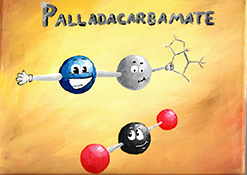
We report a palladium(ii) carbamate complex resulting from CO2 activation. The reaction proceeds very fast for a palladium(ii) terminal imido complex and slowly for the related palladium(ii) bisamido complex. Computational analysis suggests a nucleophilic addition mechanism instead of a 1,2-addition for the imido complex.
CH19236Self-Assembly of Uniform Branched Gold Nanoparticles Induced by Using Thiol-Terminated Poly(ethylene glycol)
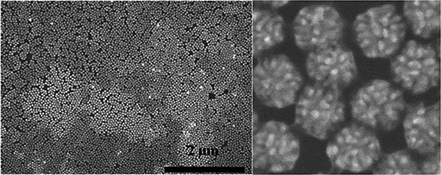
Branched gold nanoparticles with a sufficiently monodisperse distribution of size were fabricated and self-assembled into a 2D close-packed organisation.
CH19197An Anionic Calcium Metal–Organic Framework Encapsulated with TbIII Ions as a Recyclable Luminescent Sensor for CrIII and FeIII Ions
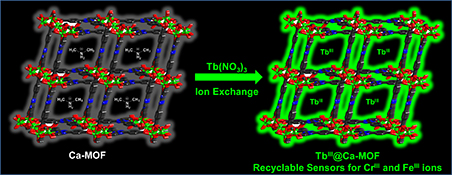
A CaII-based MOF with microporous cages containing [(CH3)2NH2]I cations was synthesised. Its TbIII-loaded material exhibits the characteristic luminescence of TbIII ions and can be used as a highly selective and recyclable luminescence probe for detection of CrIII and FeIII ions.
CH19069Salen-Based Metal Complexes and the Physical Properties of their Porous Organic Polymers
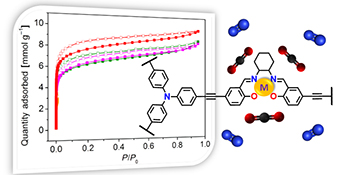
A series of new porous organic polymers (POPs) based on the bis-bromo salen ligand containing Mn, Ni, Fe, and Pd metalloligand centres are examined for properties desirable in CO2 post-combustion capture applications.



